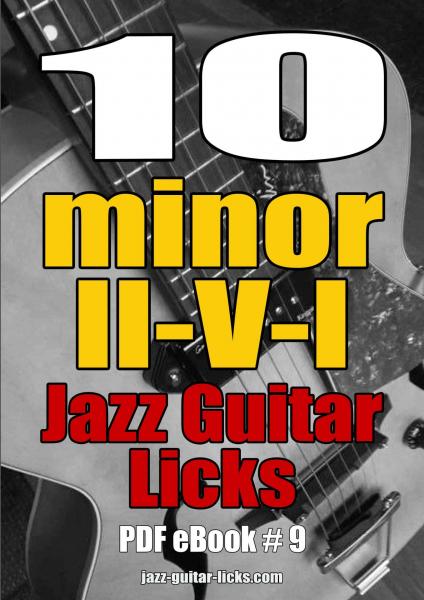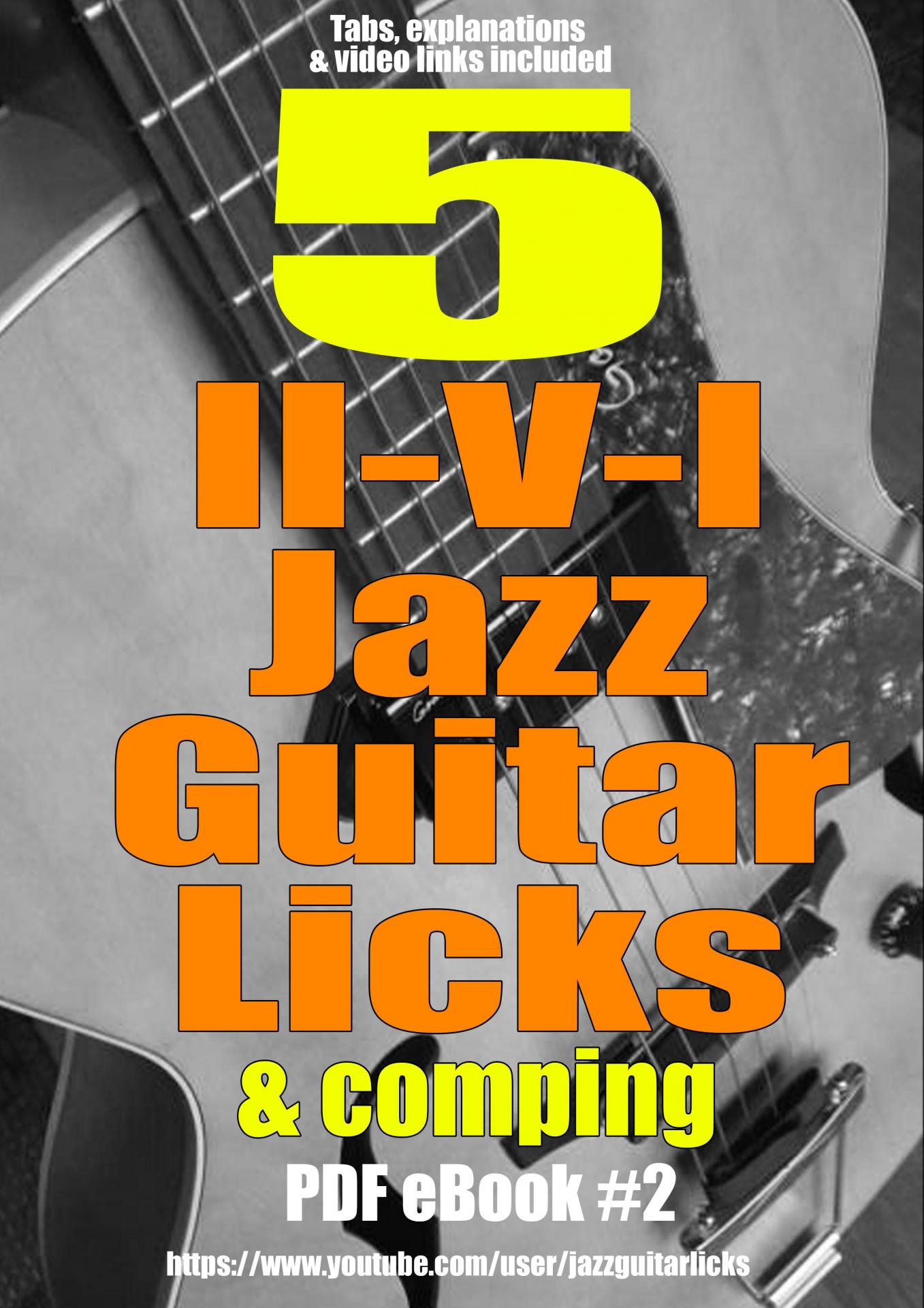So in this lesson, I’m giving you 25 easy ii-V-I licks. Bebop scales. Matias Rizzone April 2, 2017 at 10:31 am. Jeff Shirley April 13, 2018 at 4.
Checking out bebop jazz guitar licks is a huge part of learning a style of music like Bebop. This also means out how to incorporate what makes them Bebop Guitar them into your playing. This would be true both for phrasing and specific arpeggios, chromatic enclosures that are being used in Bebop.

In this video I will go over 3 good examples of Bebop Jazz Licks, and then I will analyze them and talk about how they are constructed and what the building blocks of this type of jazz lick is.
Since the bebop style is very focused on dom7th chords I have made examples of V I progression in the key of G major. It is of course also possible to use these on a II V I in G major.
In general the people who play bebop and teach it (like Barry Harris) will focus more on the dominant than the II chord in a cadence.

Bebop Jazz Guitar Lick #1
One of the really common Bebop phrasing ideas is to use 16th note scale runs in the middle of an 8th note line to create some variation. The first example here below has this in the middle of bar 1. The easiest way and to play this and get it to sound good in terms of phrasing is to use pull offs towards the target note.
Another very common device is using chromatic enclosures which what you see in the 2nd half of bar 1. The enclosure is used to target and emphasize the 3rd of D7 on the 1 of the 2nd bar.
The first half of the 2nd bar is in fact just a D7 arpeggio, but the line is constructed by playing a descending D7 arpeggio and then displacing the last three notes an octave. This yields a very beautiful and melodic 6th interval between the F# and the D.
At the end of the line I included a D augmented triad that nicely resolves to the 9th(A) of Gmaj7.
To practice playing the 16th note trills with legato you can take this exercise through a position of 3 notes per string major scale. I have only written out the first 3 string sets.
Bebop Jazz Guitar Lick #2
This example contains two ideas that you will find in a lot of bebop lines. The first is playing a 7th arpeggio with a triplet, which is how the line starts. In the line I am playing a descending Em7 arpeggio.
From here the line skips back to A for a descending scale run.
In the 2nd bar you’ll first hear a 16th note triplet trill between root and b9. This is again executed with legato. From here the line continues down the arpeggio. Inserts a leading note a half step below the 3rd of D7 and uses another octave displacement before resolving to the 3rd(B) of G
The triplet idea can be practiced in position as shown in the exercise here below. It’s an extremely good alternate picking exercise if you use that technique and will also work really well with sweeping (as I demonstrate in the video)
To work on the trill (and work on your legato technique) you can do this exercise which is taking the trill idea from the line above through a G major scale position.
Bebop Jazz Guitar Lick #3
The ascending 7th chord arpeggio with an added leading note is a very typical for bebop licks. In this example I am using that on an F#m7(b5). F#m7(b5) is the arpeggio from the 3rd of D7 and a great arpeggio to use over a D7.
From the high E I add a chromatic leading note and make a short chromatic run before going to C on the 1 of bar 2.

The 2nd bar is first a descending Cmaj7 arpeggio that then continues to the b9(Eb) on beat 3. From here the line uses octave displacement and continues with a line to resolve to the 3rd of G, and tagging it with a G. Another trademark bebop move.
To practice the arpeggios you can of course take them through the scale. There are several ways to do this, one of them is shown here below.
Making new licks with the building blocks
The main point of this lesson is of course that you can start making your own lines that sound more like bebop. To demonstrate how you might do that I have included two bebop licks that are constructed from the ideas that I used in the first three licks.
Derived Bebop Lick #1
In this first line I start with the opening idea from Lick no 3, but now I am using it on a D7 arpeggio. This is followed by a 16th note scale run fill as in the first example.
In bar 2 I continue with a descending scale run. This leads into the 3rd of D7 where I use the same octave displacement idea that I used in Lick no 2, only now played an octave higher.
In this way we end up with the lick shown here below:
Bebop Licks Pdf
Derived Bebop Lick #2
In the last lick I am starting with the 16th note trill idea from Lick no 1. This is followed by a scale run that leads into two arpeggios chained together, an Am7 and a F#m7(b5). The line ends with the “bebop” ending that resolves to a D and then drops down to the 9th(A)
I hope you can use these exercises and building blocks and the process to start incorporating some more bebop into your lines. Bebop is a very rich melodic language with a great amount of things you can use even in more modern bop based jazz guitar solos.
Get a Free Ebook
If you want to download a Free E-book of 15 II Valt I licks then subscribe to my newsletter:
You can also download the PDF of my examples here:
If you have any questions, comments or suggestions for topics or how I can make the lessons better then please let me know. Leave a comment on the video or send me an e-mail. That is the best way for me to improve my lessons and make them fit what you are searching for.
Learn Guitar Pdf
Please subscribe to my YouTube channel and feel free to connect with me via Instagram,TwitterGoogle+ or Facebook to keep up to date with new lessons, concerts and releases.
Classical Guitar Pdf
Top recording artist, educator, composer and monster jazz guitarist Sheryl Bailey dug wide and deep into the bebop soundscape to select the lines and approaches that comprise this essential vocabulary of bebop phrases. You’ll learn lines inspired by bebop giants such as Charlie Parker, Joe Viola, Joe Pass, John Coltrane, Pat Martino, Sonny Stitt, Cannonball Adderley, Mike Stern, Dizzy Gillespie, Peter Bernstein and so many more.
“Learning licks from your favorite bebop players is key to understanding the deeper harmonic nuances of the music. Organize your vocabulary of licks by harmonic situations and then plug them into your solos. In time, you’ll uncover the harmonic and rhythmic shapes behind the licks and they’ll become a part of your own musical language. That’s when you’ll really start improvising.”
As you work through these 50 essential lines, you’ll learn to apply the legendary “I’ve Got A Banana” lick, minor 7th line cliche, chromatic below/diatonic above approach, bebop scales, use of repetition, chord substitutions, chromaticism, displaced rhythms, the ‘micro-cosmic’ bebop line, arpeggios, tensions, tritone sub V7, symmetrical diminished, whole tone scale, augmented triads, 3-note melodic embellishments and many more bebop applications. All of the licks are presented over a rhythm track and then broken down note-by-note, technique-by-technique with a thorough explanation of the underlying harmony. Everything is tabbed and notated, plus you get all of the rhythm tracks to practice with by yourself.
We can’t help you with phrasebooks for Papa New Guinea but if jazz improvisation is your destination, then your ticket is but a click away.